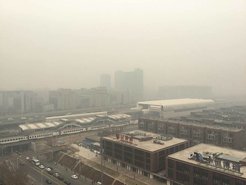Self-amplifying chemical mechanism explains severe winter haze events in China
In the aqueous phase of aerosol particles, nitrogen and sulfur oxides can react with each other and rapidly form high concentrations of fine particulate matter through a previously unrecognized mechanism.

We discovered that sulfate production increases together with the concentration of fine aerosol particles”, states Yafang Cheng, group leader at the MPI for Chemistry and first author of the study. In January 2013, she and her colleagues analyzed surface based aerosol measurements in Beijing 2013. What puzzled the scientists most was that the sulfate production rate was six times higher during the most polluted periods than those during low-moderately polluted conditions. State-of-the-art air quality models relying on sulfate production mechanisms that require photochemical oxidants, cannot predict these high sulfate levels because the photochemical activity is low due to the aerosol dimming effect.
“The enhanced sulfate production observed at reduced solar radiation levels indicated the existence of an unrecognized reaction pathway. After considering the standard pathways of gas phase, cloud and fog chemistry, there was still a large gap between modeled and observed sulfate” explains Hang Su, also group leader at the MPI for Chemistry and co-corresponding author of the study.
Finally, the Mainz scientists succeeded in finding the missing link: “Reactive nitrogen chemistry in aerosol water can explain the missing source of sulfate in the winter haze of Beijing. Water is a key component of atmospheric aerosols that enables a wide range of aqueous phase reactions”, summarizes Hang Su. Comprehensive and strict emission controls of both SO2 and NO2 are required to avoid the build-up of heavy haze events conclude Yafang Cheng and Hang Su. The researchers expect that the findings will advance the development and implementation of air pollution control strategies effectively reducing the adverse effects of haze on public health in China.

The global relevance and perspectives of the groundbreaking study are outlined by Ulrich Pöschl, director at the MPI for Chemistry: “The results show how tightly coupled multiphase processes involving gaseous, liquid, and solid substances are in our environment. They also demonstrate how important these processes are for our understanding of climate change and public health in the Anthropocene.” The Anthropocene is the current era of globally pervasive and steeply increasing human influence on planet Earth.
Original publication:
“Reactive nitrogen chemistry in aerosol water as a source of sulfate during haze events in China”: Yafang Cheng, Guangjie Zheng, Chao Wei, Qing Mu, Bo Zheng, Zhibin Wang, Meng Gao, Qiang Zhang, Kebin He, Gregory Carmichael, Ulrich Pöschl, Hang Su Science Advances, 21 Dec. 2016; DOI: 10.1126/sciadv.1601530
(The study had first been completed and submitted for peer review and publication in December 2015.)



